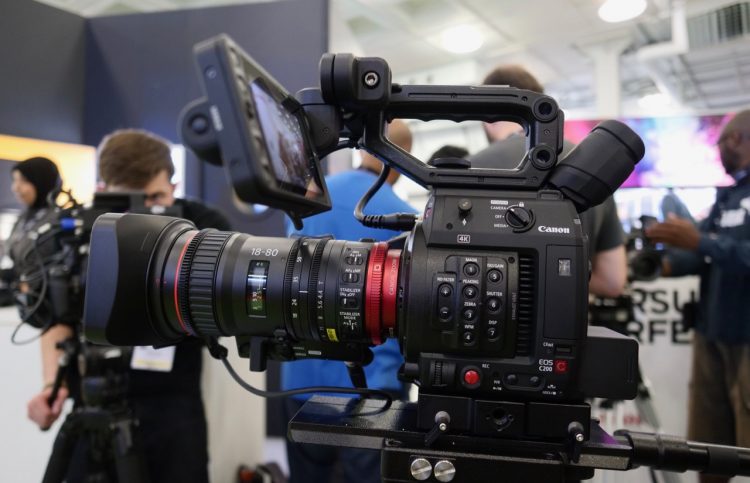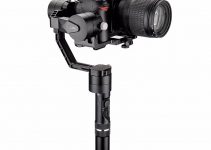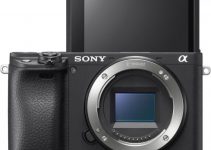One of the big announcements at this year’s CineGear Expo in Los Angeles was the newest Canon Cinema EOS camera – the Canon C200. In a somewhat of a swerve, Canon decided to include internal 4K Raw recording onto a single CFast 2.0 card in a brand new format called Cinema Raw Light in the new C200. This addition is quite exciting given where the C200 sits in the lineup – between the C100 Mark II and the C300 Mark II. The Canon EOS C200 is the first Canon EOS Cinema camera to feature such an advanced recording format, which makes it a vey enticing proposition for those looking for a new 4K camcorder.
On the other hand, Canon gimped the other recording format by including only an 8bit 4:2:0 option in MP4 for non-raw recording. XF-AVC in 8bit 4:2:2 and 305 Mbps is supposedly coming as a firmware update in early 2018, which is a damn fine codec as implemented in the Canon XC15 (assuming that it will be the same codec of course). Canon have confirmed that the XF-AVC implementation in the C200 will be indeed 8bit 4:2:2 so forget about the C200 ever being a “10bit camera”, and it makes sense for them to port the existing codec onto the S35 C200.

Canon EOS C200 at the Media Production Show 2017 in London
Melbourne based Cloakroom Media recently posted their extensive review of the Canon C200, which I think is one of the best reviews not only for the C200 out there (there aren’t that many, since they had early access to the camera), but for any camera in general that I have seen in a long time. They have also posted a series of tests and some excellent C200 footage on their Vimeo page – which I highly recommend you follow here.
CANON C200 REVIEW by Cloakroom Media from Cloakroom Media on Vimeo.
Canon EOS C200 Summary / Features
- 4K DCI Cinema RAW Light
- 4K/60p – 10 bit onto CFast 2.0
- 4K/30p – 12 bit onto CFast 2.0
- Internal Compressed Codec options:
- 4K/60p Long GOP 8bit 4:2:0 at 150 Mbps in MP4
- 4K/24/25/30p Long GOP 8bit 4:2:0 at 100 Mbps
- 2K/HD at 35 Mbps 8bit 4:2:0 in MP4
- Full HD 120fps Continuous with no sensor crop
- Records onto SD cards
- Can do 2K/Full HD Proxies on SD card and Raw on Cfast 2.0
- Up to 15-stops dynamic range (Cinema RAW Light)
- Wide DR, Canon LOG & Canon LOG 3
- Dual Pixel CMOS AF with touch control and extensive shooting functions
- Built-in NDs – 2/4/6/8/10 stops (like on C300 II)
- ACES 1.0 Support
- BT.2100 (PQ) HDR support
- HDR ST-2084 LUT (in EVF)
- Uses BP-A30 and BP-A60 batteries (same as C300 MK II)
- 8bit 4:2:2 XF-AVC 4K internal codec coming Q1 2018 as free firmware
- NO Way to Output 4K Raw (has to be recorded internally)
- HDMI Output:
- 1920 x 1080p – 10bit 4:2:2
- 3840 x 2160 – 8bit 4:2:2
- SDI Output:
- 2048 x 1080 / 1920 x 1080 – 10bit 4:2:2 – Raw Light
- 1920 x 1080 – 10bit 4:2:2
- Price:
Canon may have very well struck gold by doing what no-one else besides Blackmagic Design and RED are doing (notice both companies are not Japanese), and that is giving users an easy to work with compressed Raw format. That’s kind of a big deal, not just for the opportunities it presents, but also because it comes from Canon, who have been notoriously conservative in the (recent) past.
You can read my thoughts on the Canon C200 in more detail in this blog post here. What are your thoughts on the C200? Let me know in the comments below.
Disclaimer: As an Amazon Associate partner and participant in B&H and other affiliate programmes, we earn a small comission from each purchase made through the affiliate links listed above at no additional cost to you.




“The Canon EOS C200 is the first Canon EOS Cinema (or any) camera to
feature such an advanced recording format at a sub $10K price level”.
What about BMD’s Ursa’s? They offer internal RAW for almost half that price.
You’re correct. Fixed. Thanks,
If you’re willing to void your warranty and have some engineering chops,
you actually CAN output 4K Raw Lite EXTERNALLY by opening up the
Canon C200 camera and soldering a packet splitter chip assembly just
before the CFAST connectors on the motherboard and drilling a hole
in the case for a SATA-6 style connector to take the signal outboard
to an SSD hard drive assembly. Total Cost? Less than $400 worth of
materials and about 6-to-8 hours of time! (i.e. for the DSP resampler
chip, voltage/impedance matching and noise reduction and
signal regeneration parts and micro-soldering time!)
Of course if you’re a normal prosumer/semi-pro shooter and
HAVE NO electrical engineering experience, then DO NOT DO THIS!
BUUUUUT…….if you want to save some real bucks, you can do this
trick on C100, C300’s, 1Dc’s and almost any other camera system
if you can find out WHERE on the camera motherboard you can
get access to some pins or solder points for a split connection
you can solder onto for a RAW YCbCr/RGBA signal path
which can be split and regenerated for output externally!
Just remember the KEEP the voltage and other electrical
characteristics THE SAME across the split pins/solder points
when you do your signal regeneration back out to the signal
split point on the camera motherboard.
Add a secondary heat-sink to keep the heat down
and take into account the power draw off of your
secondary DSP/signal regen chips. You MUST
take the modified camera into an FCC or 3rd party
radio certification and electrical systems certification
facility to get the RF emissions and electrical safety
re-checked at about $500 for one single specific
user-modified item and keep multiple copies of the
NEW FCC RF emissions and CSA/UL/EU Electrical
modifications certificate with your camera AT ALL
TIMES and send a copy to your insurance company
— This is done for ELECTRONICS SAFETY REASONS!)
So INSTEAD of me paying $40,000 for a Canon C700,
I can just put in $400 worth of parts and $500 worth
of RF and Electrical re-certification and make
my C200 (and other cameras!) into a super-def RAW
video camera with RAW external video output!
That SAVES me over $30,000 which I can use to buy
me a set of Zeiss Otus 28mm, 55mm and 85mm
Canon EF mount Prime Lenses and a Sigma
150-to-600mm Sports zoom lens modified by
the Duclos Lenses Company ($15,000 for the
3 Zeiss Otus lenses and another $4500 for the
Sigma Zoom for iris declicking and cinema
follow-focus gearing. Modified C200 with
cinema-modified Zeiss Otus and Sigma
Sports Zoom Glass equals Cinematography BLISS!